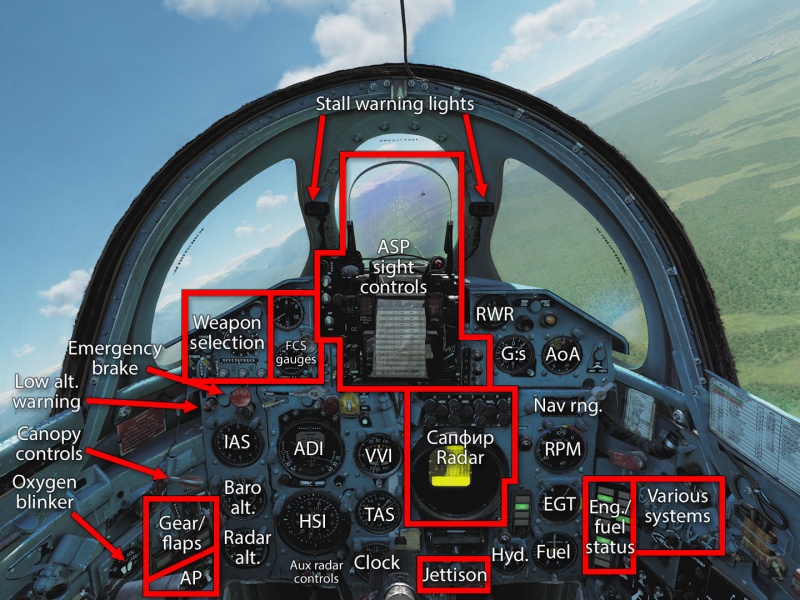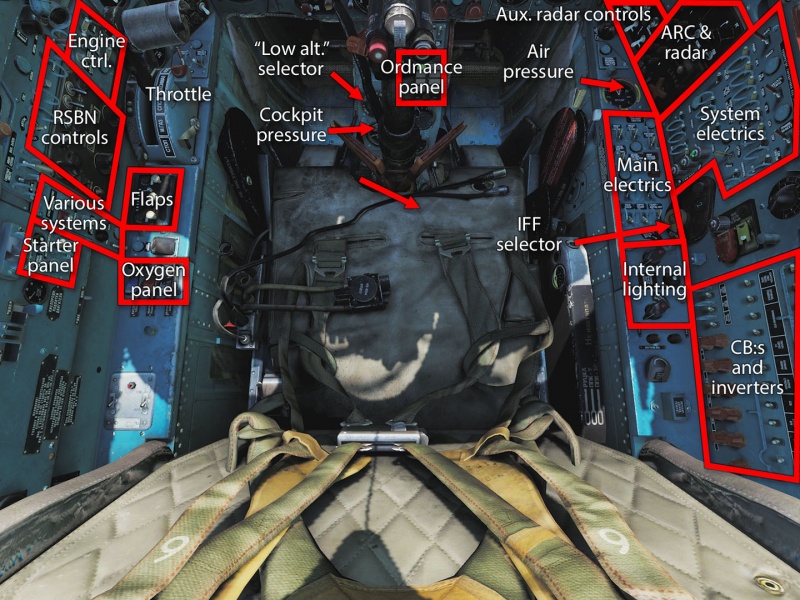MiG-21bis: Difference between revisions
m (→�) |
m (→�) |
||
| Line 44: | Line 44: | ||
[[File:MiG21-Dash.jpg|800px|frameless|MiG-21bis dashboard.]] | [[File:MiG21-Dash.jpg|800px|frameless|MiG-21bis dashboard.]] | ||
[[File:MiG21-Pit.jpg|800px|frameless|MiG-21bis cockpit.]] | [[File:MiG21-Pit.jpg|800px|frameless|MiG-21bis cockpit.]] | ||
The MiG-21bis cockpit has to be the least user-friendly workspace, if not in the world, then at least in the DCS World. Based on placement alone, vertical velocity and radar coverage seems to be the most important thing to keep track of, never mind that engine performance and speed are more critical to monitor and that to actually ''manipulate'' the Sapfir, you have to keep track of controls scattered over four different panels. | |||
Indeed, that last detail is a recurring theme for the MiG-21bis cockpit: only in rare instances will a significant number of controls for a given system be grouped together or be logically placed. The huge slab of circuit-breaker switches on the right wall might seem enough to cover the activation of almost all on-board systems, and might even be a candidate for the kind of logical grouping seen in the [[Mi-8MTV2_Magnificent_Eight|Mi-8MTV2]], but no such luck. Instead, some systems will have their CB:s scattered over other available surfaces with no rhyme or reason going into what goes where. | |||
The MiG-21bis definitely puts the “study” into study sim. | |||
=== Getting into the air === | === Getting into the air === | ||
Revision as of 03:31, 16 July 2018
| This is a beta module.
This module is still being developed and may still be missing some features and equipment options. It is playable and most of the content is there, but some final touches and fixes for minor bugs are still in the works. It is probably safe to buy unless you crave absolute fidelity and/or very few bugs. |
In DCS World, the MiG-21bis is the logical continuation of the MiG-15bis (and also, in the real world, except the actual lineage between the two have many more intermediate steps). The MiG-15 was designed to intercept high-flying B-29 strategic bombers, and as those bomber designs evolved into the B-52, the interceptors needed to evolve as well. The MiG-21 is designed to quickly scramble, climb to high altitude, and either catch up with or rapidly close with incoming aircraft. Operational range was not a huge concern, nor were sensors since GCI radar stations would guide the interceptor to the target. The on-board radar in the bis variant depicted in DCS is more for the employment of radar missiles than for detecting anything.
Even with those design constraints in mind, the MiG-21bis is also reasonably capable of performing limited air-to-ground attacks, and while not the most agile thing in the world, its engine allows it to engage in dogfighting without necessarily being on the defensive.
Features
The MiG-21bis is as old as they come in DCS without being hopped-up prop planes (or just regular prop planes), and as such comes with all kinds of old-timey toys:
- СПРД-99 (JATO) rockets and a drag chute for (some semblance of) STOL operations.
- A reasonably competent autopilot system that even includes ILS (or rather PRMG) following approach automation.
- The even-simpler-than-normal СПО-10 RWR.
- A very temperamental (but strong) engine that will stall out, flame out, or just starve if you try anything fancy.
- The even more temperamental РП-22СМ «Сапфир-21» radar that lacks look-down capability and gets easily confused by chaff, clouds, or the ground.
- A whole slew of IR air-to-air missiles, but also the R-3R and RS-2US SARH missiles. Sometimes, they even track.
- Kh-23 and Kh-66 radar beam-riding AGMs.
- Nukes. When temperaments just get too high.
Comes with the built-in campaign Stillness in Time.
Missing features
In spite of being quite old at this point, the MiG-21bis remains marked as “early access” in the DCS shop for the simple reason that it was never actually finished for complex business-splitting reasons. It is sold and maintained as a Magnitude 3 product; early presentations and previews talk of it as being made by Leatherneck; and it often comes up in discussions with the Heatblur developers. So… yeah.
At any rate, this early-access:ness reveals itself in a couple of ways:
- Alterations are made very slowly, and bad ones tend to stick around for a very long time. In particular it has been plagued with numerous art issues, such as 3D mesh errors and overly enthusiastic shaders.
- The manual is laughably lacking in actual in-depth description of how to operate much of the MiG-21bis' equipment.
- Some custom features (kneeboard, RSBN navigation suite) are not updated to be fully compatible with more recent features and modules or to make use of new generic solutions that have built into DCS since the MiG-21bis' initial release.
Of these, strangely enough, the ones that seem to be the biggest bother are the art problems, especially the (currently) famous over-smeary and over-reflective canopy shader that can make it more difficult than usual to see far away targets from inside the cockpit. There are numerous mods to fix this, and plenty of community resources to fill in the other gaps. It is still a fully working aircraft with a proper flight model, unlike such disasters as the C-101 or Hawk modules.
Flying the MiG-21bis
The MiG-21bis is a high-thrust delta wing, which makes it interesting, let us say, to fly. It climbs like a rocket, goes very fast, but those tiny wings make it wobbly at low speeds and does not like to change directions in a hurry. Or, rather, while it is more than able to pull the nose in any direction you might desire, doing so only results in truly horrendous AoA:s that lead to rapid energy losses, and possibly even engine flame-outs, but very little in the way of actual turning speed.
At the same time, if you keep the balance right, it can sustain a high-speed turn almost indefinitely, and can maintain surprisingly high turn rates — it just will not translate into staying on a the enemy's tail. It will do very well in boom-and-zoom engagements, even compared to much more modern aircraft, but will be woefully out of its depth if lured into a turn fight.
The high-speed characteristics also make it terrifying to land. You will not employ any kind of glidepath approach where you lazily waft down to the runway. Doing so means you will have to maintain such a high AoA that you can not see the runway until you notice that it is 400m to your left and you have just parked inside the control tower. Instead, you dive in at high speed (190-200kts or somewhere just below 400km/h or thereabouts will do just fine), with a shallow approach and low AoA, and rely on a sturdy landing gear, speed brakes and a drag chute to not completely overshoot the runway.
Cockpit overview
The MiG-21bis cockpit has to be the least user-friendly workspace, if not in the world, then at least in the DCS World. Based on placement alone, vertical velocity and radar coverage seems to be the most important thing to keep track of, never mind that engine performance and speed are more critical to monitor and that to actually manipulate the Sapfir, you have to keep track of controls scattered over four different panels.
Indeed, that last detail is a recurring theme for the MiG-21bis cockpit: only in rare instances will a significant number of controls for a given system be grouped together or be logically placed. The huge slab of circuit-breaker switches on the right wall might seem enough to cover the activation of almost all on-board systems, and might even be a candidate for the kind of logical grouping seen in the Mi-8MTV2, but no such luck. Instead, some systems will have their CB:s scattered over other available surfaces with no rhyme or reason going into what goes where.
The MiG-21bis definitely puts the “study” into study sim.
Getting into the air
Shooting something
Links and files
- Chuck's MiG-21bis guide.
- DCS: MiG-21bis by Magnitude 3 LLC in the DCS shop.
More information
- Mikoyan-Gurevich MiG-21 on wikpedia.
- MiG-21 FISHBED on globalsecurity.org
- Bunyap's Test Flight Preview - DCS: MiG-21 Bis Fishbed video series.




